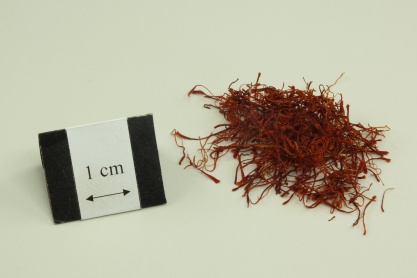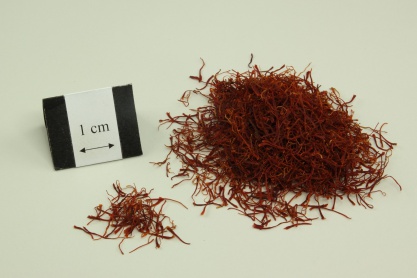- ENG
- Saffron
- LATIN
- Croci Stigma
| Medicinal Group | Blood-activating menstruation regulating medicinal |
|---|---|
| Source | Dried stigma of Crocus sativus L. (Fam. Iridaceae) |
| Nature and Flavors | sweet; neutral |
| Meridian Affinity | Liver, Heart |
| Actions | To activate blood circulation and eliminate blood stasis, cool the blood and detoxify, and tranquilize |
Family
Part used
Indications
Amenorrhea with abdominal aggregation accumulation; blood stasis after childbirth; eruptions in infectious diseases; emotional dejection, mania
Research Findings
- Saffron can be considered as a treatment option for diabetic men with erectile dysfunction.[1]
- There is initial support for the use of saffron for the treatment of mild-to-moderate depression.[2]
- Saffron may improve the symptoms and the effects of depression, premenstrual syndrome, sexual dysfunction and infertility, and excessive snacking behaviors.[3]
- Saffron showed effectiveness as an antidepressant drug, anti-Alzheimer effect , skin care effects , etc. [4]
- Saffron odor exert some effects in the treatment of premenstrual syndrome, dysmenorrhea and irregular menstruation.[6]
- Saffron showed a positive effect on sexual function with increased number and duration of erectile events seen in patients with erectile dysfunction.[7]
- The efficacy of Crocus sativus L in the treatment of premenstrual syndrome is indicated. [8]
Cautions
Use with caution during pregnancy
Report on adverse effect
At high doses (more than 5 g/die day), saffron should be avoided in pregnancy owing to its uterine stimulation activity.[5]
The lethal dose of Stigma Croci is reported to be 20.0 g; however, smaller doses may cause vomiting, uterine bleeding, bloody diarrhoea, haematuria, bleeding from the nose, lips and eyelids, vertigo, numbness and yellowing of the skin and mucous membranes [9]
Oral administration of 5.0 g resulted in localized skin haemorrhages, marked thrombocytopenia, and abnormalities of blood clotting in one patient [10]
Reference
Reference
- Mohammadzadeh-Moghadam H, Nazari SM, Shamsa A, Kamalinejad M, Esmaeeli H, Asadpour AA, Khajavi A. (2015). Effects of a Topical Saffron (Crocus sativus L) Gel on Erectile Dysfunction in Diabetics: A Randomized, Parallel-Group, Double-Blind, Placebo-Controlled Trial. J Evid Based Complementary Altern Med. , 20(4):283-6. doi: 10.1177/2156587215583756. Epub 2015 May 6.
- Lopresti AL, Drummond PD. (2014). Saffron (Crocus sativus) for depression: a systematic review of clinical studies and examination of underlying antidepressant mechanisms of action. Hum Psychopharmacol. , 29(6):517-27. doi: 10.1002/hup.2434. Epub 2014 Sep 22.
- Hausenblas HA, Heekin K, Mutchie HL, Anton S. (2015). A systematic review of randomized controlled trials examining the effectiveness of saffron (Crocus sativus L.) on psychological and behavioral outcomes. J Integr Med. , 13(4):231-40. doi: 10.1016/S2095-4964(15)60176-5.
- Moshiri M, Vahabzadeh M, Hosseinzadeh H. ( 2015). Clinical Applications of Saffron (Crocus sativus) and its Constituents: A Review. Drug Res (Stuttg). , 65(6):287-95. doi: 10.1055/s-0034-1375681. Epub 2014 May 21.
- Poma A, Fontecchio G, Carlucci G, Chichiriccò G. (2012). Anti-inflammatory properties of drugs from saffron crocus. Antiinflamm Antiallergy Agents Med Chem. , 11(1):37-51.
- Fukui H, Toyoshima K, Komaki R. (2011). Psychological and neuroendocrinological effects of odor of saffron (Crocus sativus). Phytomedicine. , 18(8-9):726-30. doi: 10.1016/j.phymed.2010.11.013. Epub 2011 Jan 15.
- Shamsa A, Hosseinzadeh H, Molaei M, Shakeri MT, Rajabi O. (2009). Evaluation of Crocus sativus L. (saffron) on male erectile dysfunction: a pilot study. Phytomedicine , 16(8):690-3. doi: 10.1016/j.phymed.2009.03.008. Epub 2009 May 9.
- Agha-Hosseini M, Kashani L, Aleyaseen A, Ghoreishi A, Rahmanpour H, Zarrinara AR, Akhondzadeh S. (2008). Crocus sativus L. (saffron) in the treatment of premenstrual syndrome: a double-blind, randomised and placebo-controlled trial. BJOG. , 115(4):515-9. doi: 10.1111/j.1471-0528.2007.01652.x.
- Bisset NG. Herbal drugs and phytopharmaceuticals. Boca Raton, FL, CRC Press, 1994.
- Frank A. Auffallende Purpurea bei artifi ziellem Abort. [Purpurea resulting from artifi cial abortion.] Deutsche Medizinische Wochenschrift, 1961, 86:1618.












